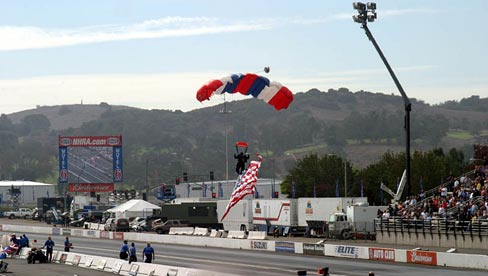
SALUTE?
And oh, say, can you see the day when opening
ceremonies include a respectful treatment of
the Stars and Stripes?
NHRA's wunderplanners need to come up with
a better way to honor America that stops desecrating
the flag and jeopardizing lives of parachutists.

(Zak Hawthorne photo)
What so proudly we hailed ends up crumpled
and soiled as it falls onto a race track on
which no one normal would want to place his
clean laundry. It's a wonder the military color
guards, who do a marvelous job and bring a welcome
sense of decorum to each national event, haven't
fainted when Old Glory flutters unprotected
to the ground. And why haven't veterans in the
grandstands not been appalled enough to lobby
for a more fitting salute to our flag?
NHRA is right in wanting to honor America and
the flag. And who can blame it if it wants to
do so in a crowd-pleasing way? The pre-race
show simply needs to be unique or splashy in
a style befitting this precious symbol. We can
be like that old man on the courthouse square
in one of Johnny Cash's ballads -- we can be
mighty proud of that ragged old flag. But these
flags at NHRA ceremonies should not be ragged
and dirty and shamed by being dropped onto the
ground.
Furthermore, NHRA needs to stop this nonsense
of involving skydivers in the process. Evidently
the death of experienced 59-year-old parachutist
Lawrence Yohn at Pomona Raceway in November
1999 wasn't enough to make NHRA rethink the
idea. An incredible incident Sunday morning
at the Finals once again showed how little NHRA
must value these parachutists anyway.
Protocol is for the parachutist with the flag
to synchronize his landing with the conclusion
of the national anthem. In this latest case,
it was clear halfway through the "Star-Spangled
Banner" that the diver was way too high in the
air to hit his mark at the prescribed time.
Graham Light, NHRA Senior Vice-President of
Racing Operations, was eager to fire up the
first pair of dragsters and didn't seem keen
on the idea of waiting for the parachutist to
land.
He told the man who was the two-way radio link
to the skydiver to instruct the diver to land
somewhere else besides on the track, suggesting
the parking lot or somewhere on the fairgrounds
away from the action. The man ignored Light's
directive, but the skydiver did not come down
at a leisurely pace. He landed hard and fast.
His mission was changed in mid-dive and his
safety jeopardized, and NHRA ought to consider
itself lucky that it didn't have another parachutist
death to explain.
Of course, NHRA could remove that possibility
forever by discontinuing the routine. It's not
wowing the crowds. It's not unique. Causing
the audience to gasp and worry about the safety
of the parachutists -- and possibly their own
-- is not entertaining. It's frightening.
So will attitudes change by the Feb. 19-22
Winternationals? It's up to NHRA whether it
is willing to do some soul-searching.

|